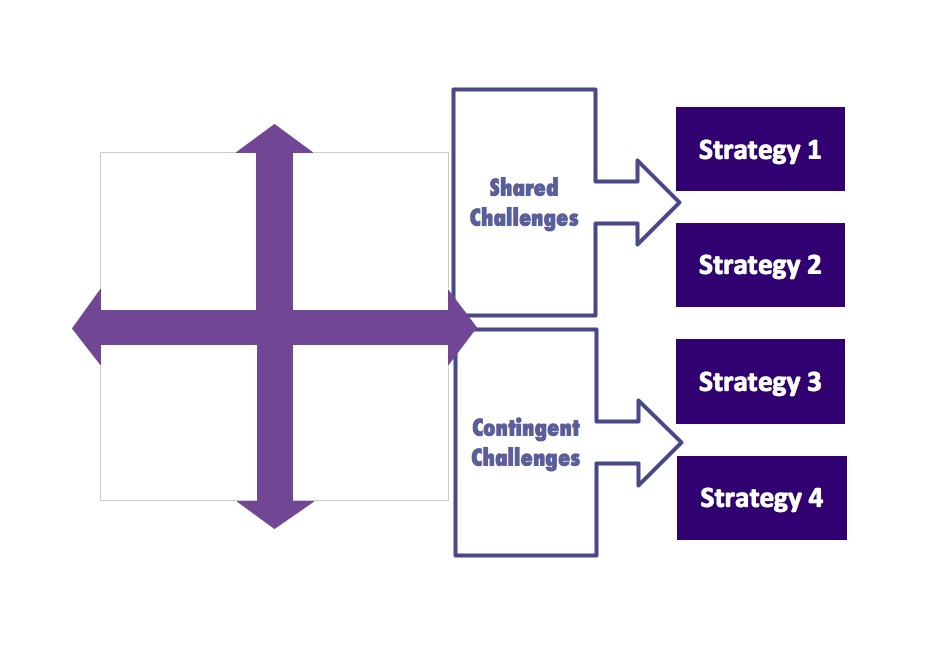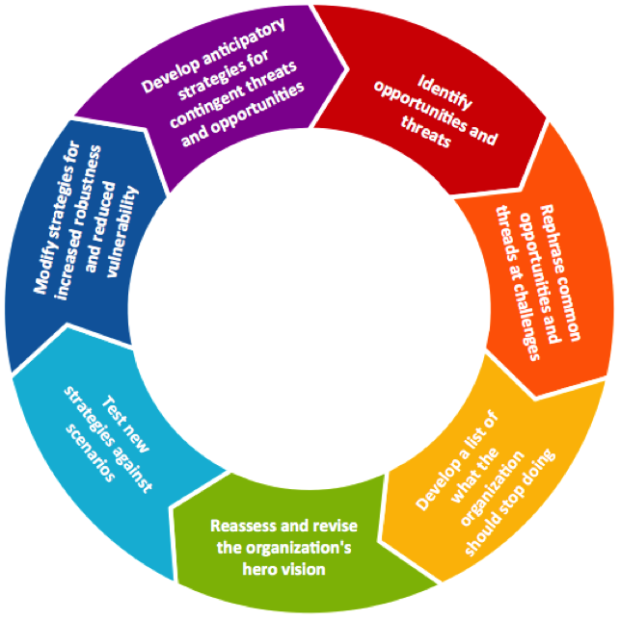Strategies from Scenarios
The future is complex and the paths forward a messy one. That has to be agreed to first. Any organization that thinks it controls its own destiny and can create the future in whole cloth does not need to read this article. For those who do agree that the future is messy, they must also acquiesce that navigating uncertainty requires sophistication. When uncertainty is involved navigation requires the practice of skills one may not have acquired yet, or even considered. And that is why scenario planning remains the only tool that helps individuals and organizations imagine the messiness of the future.

Over the last several decades many industries have disappeared, and the leaders in those industries either disappeared with them, or were forced to change, often at great cost. Political systems once so seemingly intransigent have also fallen victim to the unfolding of history. TDK, once a prominent, high-end maker of cassette tapes and CD-ROMs, still exists as an industrial and consumer electronics manufacturer, but is no longer the darling of audiophiles. Its competitor, Memorex, also found its fortunes lost as tape and optical media lost out to solid state storage. Both once prominent consumer brands share a home at Imation, an accumulator of storage technologies.
Adapting to Shifting Sands
These shifting sands of fortune beg the question: how can any organization adapt to change? Not market position nor capital, not human capital nor superior processes will help an organization change if it doesn’t anticipate shifts and imagine responses ahead those shifting sands. That is where scenario planning plays an important role, one that few organizations have used, and even fewer have mastered.
Scenario planning creates context. Even before the scenarios are written, scenario planning forces organizations to confront uncertainty and forces beyond their control. This exercise is itself a humbling awakening to managers so often focused on maximizing the utility of things they can control. And when the scenarios arrive, the various futures can be not only thought provoking, but they can also make participants very uncomfortable. When discomfort takes hold, it is often easier to dismiss the process as an ill-advised investment in fiction, than to take up the challenge to re-perceive one’s assumptions about the future.
Those who do choose to actively engage with the scenarios find them valuable tools in a strategic planning quiver. Traditional strategic planning tools, like SWOT analysis, when applied to a generic unarticulated present, or a linearly extrapolated vision of the future, creates a single set of challenges. There is no hedging or uncertainty. The context is fixed and therefore the strengths, weaknesses, opportunities and threats are equally fixed within the assumptive framework, be it articulated or not. If people disagree with the conclusions, they are unsupported by a framework that would reinforce their challenge.
For organizations who apply SWOT within the scenario framework, something that is a strength under one set of social, technological, economic, environmental and political circumstances may well prove a weakness under different conditions. This does not imply that the ultimate assignment of that characteristic be one or the other under present circumstances, only that in an uncertain future placing a wrong bet can be an issue. The scenarios create different contexts, and therefore required different strategies in order to overcome weakness, or maintain or wield a strength. The same is true of opportunities and threats. Under some circumstances a threat becomes an opportunity, while opportunities in one future may yield nothing in another. This exploration helps those grappling with the messiness of the future envision that messiness in a shared way, through the mechanism of stories to which everyone can relate.
The Role of Scenarios in Strategy
When it comes to strategy then, there are two places that scenarios can play a role. The first is in the identification of the strategy. A strategy is contingent upon the future in which it exists. But because the scenarios exist in a matrix, those in scenarios above the horizontal line and below, and those left and right of the vertical axes, share certain characteristics. Therefore, common challenges can arise when speculating about the scenarios, which reinforce the potential value of those strategies. Purely contingent challenges apply to only one future. We will return to contingent challenges in a moment.
In scenario planning, the hero vision always acts as an extra version of the future, one often less robustly articulated or deeply considered as the future scenarios. The ultimate expression of scenario planning adoption is the recognition of the hero vision as being strictly aspirational, and the incorporation of ideas from the scenarios into the vision. From the process standpoint, a hero vision should also act as the end state at the edge of the strategic planning horizon.
Secondly, scenarios help test the robustness and resilience of existing and new strategies by providing circumstances for them to play out that are different from those assumed when they were created.
The identification of emergent strategies or shared challenges should be examined in light of whatever hero vision the organization works from. Because the scenarios often include elements not considered in the hero vision, the challenges described in the scenarios may be new to the discussion, and therefore valued as revelatory as an undiscovered challenge the organization already faces. At minimum, these challenges should be analyzed and integrated into the existing set of organizational strategies as potential strategies. Those that match current strategies simply reinforce existing positions.
Strategies are developed in response to a challenge. In higher education, the challenge of providing access to education at a reasonable price is a current strategic issue for colleges and universities. Strategies for dealing with tuition expense increases, from cost controls to revamping governance structures, from advocating for tighter control on loans to negotiating with Congress on price fixing, all apply to the moment. They are fixed in reality and will remain issues in the future, unless some fundamental change occurs, which is what is happening with disruptive business models of education as well as with the perceptions of value derived from a formal, four-year traditional education. Regardless of the challenge, organizations need to create a set of strategies designed to overcome the challenge.
When scenarios produce discomfort, they also offer new degrees of freedom, and by exploring the source of the discomfort, that exploration can generate innovative strategic solutions. The existence and active use of scenarios provides a tacit approval to at least explore unconventional strategies.
Given the messiness and uncertainty of the future, contingent challenges play an important role in helping an organization prepare itself for change. There may exist in the scenarios wildly divergent ways to, for instance, recruit students to a college. Organizations that employ scenarios effectively would create a straw strategy, and talk themselves through its implementation and potential ramifications within the context of the scenario stories. This helps them prepare for change by practicing it. If any of the contingencies eventually arrive as the actual future, those using scenarios well will both be actively watching for indicators of the new conditions, and they will have already discussed and practiced a strategy to meet the challenge.
Making Scenarios Work For Strategy
As strategies coalesce, the scenarios can play the role of agitator and challenger. The organization can use the scenario to test the strategy. How does it perform in this future? What would need to be done differently? Would modifying the strategy to make it more flexible cost that much more in order to ensure future utility? If so, how do we prepare for abandoning this strategy if our assertions about the future prove wrong?
Those questions, and many others, derive from the scenarios creating an array of strategic contexts, and from the forcing function of knowing, and admitting, what can’t be known.
Strategies are responses to challenges. The scenario canvas helps paint multiple contexts, and those contexts lead to richer, more diverse and more varied challenges. It is up to every organization to develop strategies that respond to challenges by leveraging their unique strengths and talents, or strengths and talents they are developing in anticipation of a future they might otherwise have been ill-prepared for had they not embraced scenarios to help them navigate the messiness of the future.
Summary: Using Scenarios to Inform Strategy
- Identify opportunities and threats. Search each scenario independently. Consolidate the analysis and identify common opportunities and threats.
- Rephrase the common opportunities and threats as challenges. Develop strategies that either mitigate risk from threats or leverage opportunities.
- Develop a list of what the organization is doing that doesn’t fit with any imagined future and develop strategies to curtail or eliminate those investments and activities.
- Reassess the organization’s “hero vision” in light of the scenarios and this strategic assessment in order to ground the strategies. Rewrite, consolidate and fully articulate a final set of organizational strategies.
- Test the new strategy against the scenarios to assess their degree of anti-fragility.
- Modify the strategies as necessary to make them more robust and less vulnerable.
- Develop anticipatory strategies for the contingent threats and opportunities.


